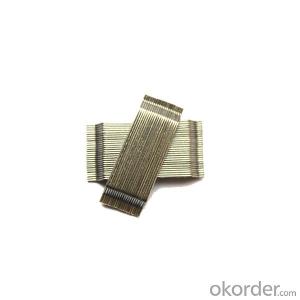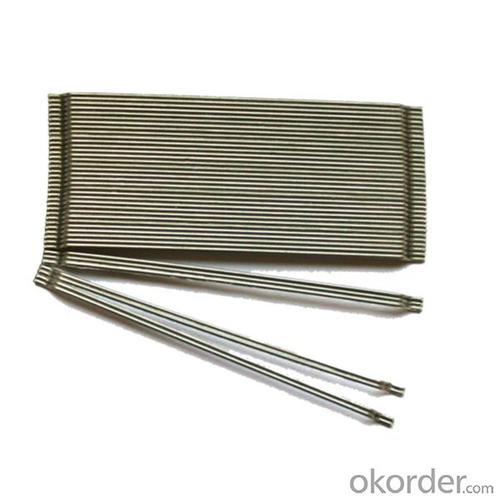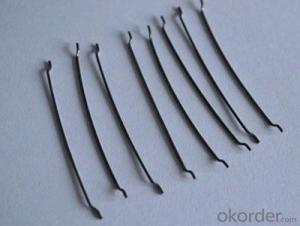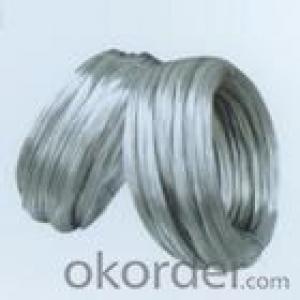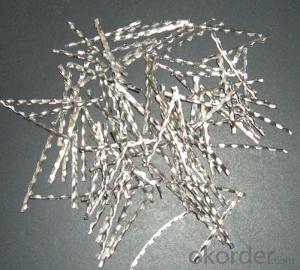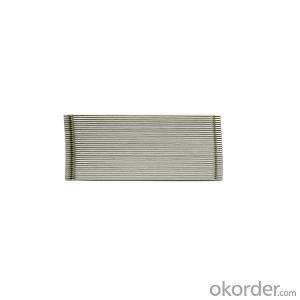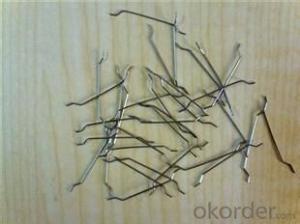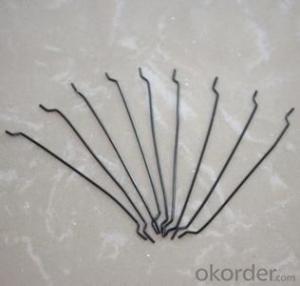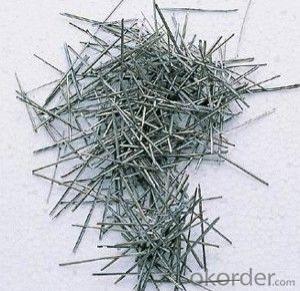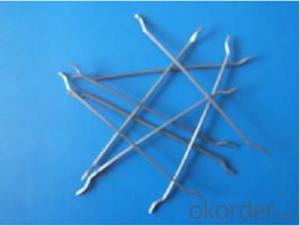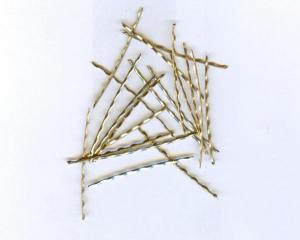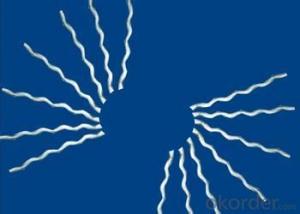Melt Extract Stainless Steel Fiber 0.75/30 Concrete Steel Fiber from CNBM China
- Loading Port:
- Tianjin
- Payment Terms:
- TT OR LC
- Min Order Qty:
- 1 m.t.
- Supply Capability:
- 5000 m.t./month
OKorder Service Pledge
Quality Product, Order Online Tracking, Timely Delivery
OKorder Financial Service
Credit Rating, Credit Services, Credit Purchasing
You Might Also Like
Quick Details
Place of Origin: Tianjin, China (Mainland)
Model Number: 0.75
Material: Steel
Production Process: Cold drawn
Lengh: 30
Type: 1
Compressive Strength: >1200MPa
Aspect ratio: 40
Standard: ASTM A820M-11
Section Shape: Circular
Application: Concrete Reinforcement
Packaging & Delivery
| Packaging Details: | 20 kg/Bag,50 bags/Pallet or 1,000kg/ Bulk Bag |
|---|---|
| Delivery Detail: | 1 Month |
Product Description
| Diameter | 0.75 | mm | 0.03 | in |
| Length | 30.00 | mm | 1.18 | in |
| Aspect Ratio | 40 | |||
| Tensile strength | 1200 MPa | |||
| Type | Cold drawn Steel Fiber | |||
| End | Hooked-end Steel Fiber | |||
| Glued/Loose | Glued Steel Fiber | |||
| Bending Angle | 45°(min.30°) | |||
| Usage & Performance | Floor:Trafficked areas and Industrial floors | |||
| Shotcrete :Slope stabilization and Final lining | ||||
| Precast concrete:Pipe and Railway sleepers | ||||
| Packing | Standard Export Pallet Packing | Bag Packing | 20 kg/Bag,50 bags/Pallet | |
| Bulk Packing | 1,000kg/ Bulk Bag | |||
| Loading Quantity | 20’GP | 20-25 Tonne/Tonnes | ||
| 40’GP | 25-27 Tonne/Tonnes | |||
| 40’HQ | 25-27 Tonne/Tonnes | |||
| MOQ | 1 kg for trial order | |||
| Supply Ability | 10,000 Tonne/Tonnes per Year | |||
| Payment Terms | T/T or L/C at sight | |||
| Delivery Time | Within 15 days after receiving deposit or original L/C at sight | |||
| Certification | ISO9001:2000, CE, | |||

| Product | Diameter | Length mm/in | Aspect Ratio | Type | Packing |
| G-6030 | 0.5 mm (0.0197 in) | 30 mm (1.1811 in) | 60 | Glued | 20 kg/Bag, or 1,000kg/ Bulk Bag |
| G-6535 | 0.55 mm (0.0217 in) | 35 mm (1.3780 in) | 65 | Glued | 20 kg/Bag, or 1,000kg/ Bulk Bag |
| G-6035 | 0.6 mm (0.0236 in) | 35 mm (1.3780 in) | 60 | Glued | 20 kg/Bag, or 1,000kg/ Bulk Bag |
| G-8060 | 0.75 mm (0.0295 in) | 60 mm (2.3622 in) | 80 | Glued | 20 kg/Bag, 50 bags/Pallet |
| G-6060 | 0.9 mm (0.0354 in) | 60 mm (2.3622 in) | 60 | Glued | 20 kg/Bag, 50 bags/Pallet |
| G-6030 | 0.5 mm (0.0197 in) | 30 mm (1.1811 in) | 60 | Loose | 20 kg/Bag, or 1,000kg/ Bulk Bag |
| G-6535 | 0.55 mm (0.0217 in) | 35 mm (1.3780 in) | 65 | Loose | 20 kg/Bag, or 1,000kg/ Bulk Bag |
| G-6035 | 0.6 mm (0.0236 in) | 35 mm (1.3780 in) | 60 | Loose | 20 kg/Bag, or 1,000kg/ Bulk Bag |
| G-8060 | 0.75 mm (0.0295 in) | 60 mm (2.3622 in) | 80 | Loose | 20 kg/Bag, 50 bags/Pallet |
| G-6060 | 0.9 mm (0.0354 in) | 60 mm (2.3622 in) | 60 | Loose | 20 kg/Bag, 50 bags/Pallet |
- Q: How does melt extract stainless steel fiber improve the freeze-thaw resistance of concrete?
- Melt extract stainless steel fiber is an innovative material that greatly enhances the freeze-thaw resistance of concrete. This type of fiber is derived from stainless steel through a specialized extraction process, which ensures its purity and high-quality characteristics. The freeze-thaw resistance of concrete refers to its ability to withstand the repeated cycles of freezing and thawing that occur in cold weather conditions. When water trapped within the concrete freezes, it expands, exerting pressure on the surrounding material. This pressure can cause cracks, spalling, and other forms of deterioration in the concrete structure over time. By incorporating melt extract stainless steel fibers into the concrete mix, several mechanisms come into play to improve its freeze-thaw resistance. Firstly, the fibers act as reinforcement within the concrete matrix, providing additional tensile strength and reducing the formation and propagation of cracks. This helps to maintain the overall structural integrity of the concrete, even when subjected to freeze-thaw cycles. Moreover, the stainless steel composition of these fibers offers excellent corrosion resistance. Concrete is often exposed to various environmental factors, including the presence of chloride ions from de-icing salts, which can accelerate the corrosion process. However, the stainless steel fibers inhibit the corrosion of embedded reinforcing steel, thereby preserving the concrete's durability and freeze-thaw resistance. Additionally, the presence of melt extract stainless steel fibers enhances the overall durability of the concrete. These fibers improve the cohesion and bond between the aggregate and cement paste, resulting in a more dense and impermeable concrete matrix. This reduces the ingress of water and other harmful substances, such as chloride ions, into the concrete, further safeguarding it against freeze-thaw damage. In conclusion, melt extract stainless steel fiber plays a crucial role in enhancing the freeze-thaw resistance of concrete. By providing reinforcement, corrosion resistance, and improved durability, these fibers effectively mitigate the detrimental effects of freeze-thaw cycles on concrete structures, ensuring their longevity and integrity.
- Q: Can melt extract stainless steel fiber be used in ultra-high-performance concrete (UHPC)?
- Indeed, melt extract stainless steel fiber is a viable option for utilization in ultra-high-performance concrete (UHPC). UHPC is renowned for its outstanding robustness, endurance, and augmented performance attributes, and the inclusion of stainless steel fibers can further heighten these qualities. Melt extract stainless steel fibers are specifically engineered to enhance the tensile strength, malleability, and resistance to fissuring of concrete. Furthermore, they offer exceptional resistance to corrosion, which is pivotal for long-lasting sustainability in aggressive surroundings. Moreover, the diminutive diameter and elevated aspect ratio of these fibers facilitate enhanced dispersion and adhesion within the concrete structure, resulting in improved crack resistance and overall performance. Consequently, integrating melt extract stainless steel fibers in UHPC can significantly enhance its mechanical properties and lifespan, rendering it a suitable option for demanding applications such as skyscrapers, infrastructure undertakings, and precast elements.
- Q: What is the effect of melt extract stainless steel fiber on the modulus of deformation of concrete?
- The incorporation of melt extract stainless steel fiber in concrete generally leads to an increase in the modulus of deformation. This is due to the high tensile strength and superior bonding properties of stainless steel fibers, which enhance the overall structural integrity and stiffness of the concrete matrix. Additionally, these fibers also help to reduce cracking and enhance the flexural strength and durability of the concrete.
- Q: How does melt extract stainless steel fiber improve the fire resistance of shotcrete?
- Melt extract stainless steel fiber improves the fire resistance of shotcrete by providing enhanced structural integrity and heat resistance. The fibers act as reinforcement, reducing cracking and spalling during high temperatures. This helps to maintain the structural stability of the shotcrete, preventing it from collapsing or disintegrating under fire conditions. Additionally, the stainless steel fibers create a barrier that slows down heat transfer, reducing the spread of fire within the shotcrete. Overall, the inclusion of melt extract stainless steel fiber significantly enhances the fire resistance of shotcrete, making it a more reliable and durable material for fire protection applications.
- Q: How does melt extract stainless steel fiber enhance the resistance of concrete to corrosion?
- Melt extract stainless steel fiber enhances the resistance of concrete to corrosion through its unique properties and characteristics. When added to concrete as a reinforcement material, stainless steel fiber acts as a barrier against corrosive agents and prevents their penetration into the concrete matrix. One of the main reasons why stainless steel fiber is effective in enhancing corrosion resistance is its high corrosion resistance itself. Stainless steel is composed of iron, chromium, and other alloying elements that create a protective oxide layer on its surface. This oxide layer acts as a shield against corrosive elements such as chloride ions, which are one of the main causes of corrosion in concrete structures. As a result, the stainless steel fiber prevents the penetration of chloride ions into the concrete, reducing the risk of corrosion. Furthermore, the presence of stainless steel fiber in concrete also improves the overall durability and lifespan of the structure. Stainless steel fibers help to increase the tensile strength and flexural strength of concrete, making it less prone to cracking or spalling. By reinforcing the concrete matrix, stainless steel fiber enhances its ability to withstand external loads and environmental factors, including corrosive agents. Additionally, stainless steel fiber has a high aspect ratio, meaning it is relatively long and thin. This characteristic allows the fibers to create a three-dimensional reinforcement network within the concrete, improving its resistance to cracking and reinforcing its overall structure. This network of fibers also acts as a physical barrier that prevents the movement of corrosive elements, such as water and oxygen, within the concrete, further reducing the risk of corrosion. In conclusion, melt extract stainless steel fiber enhances the resistance of concrete to corrosion by providing a high level of corrosion resistance, improving the overall durability and lifespan of the structure, and creating a three-dimensional reinforcement network within the concrete. These properties make stainless steel fiber an effective solution for enhancing the corrosion resistance of concrete structures, ultimately increasing their longevity and reducing maintenance and repair costs.
- Q: Can melt extract stainless steel fiber be used in architectural concrete applications?
- Yes, melt extract stainless steel fiber can be used in architectural concrete applications.
- Q: How does melt extract stainless steel fiber improve the impact resistance of shotcrete?
- Melt extract stainless steel fiber is a type of reinforcement material that is added to shotcrete, a highly versatile construction material used in various applications. When added to shotcrete, this stainless steel fiber greatly enhances the impact resistance of the material. The key reason behind this improvement lies in the unique properties of stainless steel fiber. Firstly, stainless steel is known for its high tensile strength, which means it can withstand high amounts of force without breaking or deforming. This property allows the stainless steel fiber to effectively distribute and absorb impact energy, thereby reducing the likelihood of cracks or fractures in the shotcrete. Additionally, the melt extract process used to produce these fibers ensures a high level of uniformity and consistency in their shape, size, and distribution. This uniformity contributes to the overall stability and durability of the shotcrete, making it more resistant to impact loads. Furthermore, the addition of stainless steel fibers to shotcrete enhances its ductility. Ductility refers to the material's ability to deform without fracturing. By increasing the ductility of shotcrete, the stainless steel fibers allow it to better absorb energy during impact events, preventing sudden failures or catastrophic damages. Overall, the use of melt extract stainless steel fibers in shotcrete significantly improves its impact resistance by enhancing its tensile strength, stability, durability, and ductility. This makes shotcrete reinforced with stainless steel fibers an ideal choice for applications where impact loads are expected, such as in tunnel linings, bridge abutments, or protective barriers.
- Q: What is the recommended fiber dosage when using melt extract stainless steel fiber in shotcrete?
- The appropriate amount of melt extract stainless steel fiber to use in shotcrete can vary depending on the specific project requirements and desired performance characteristics. Generally, it is recommended to use a fiber dosage of 20 to 40 kilograms per cubic meter (kg/m3) or 1.2 to 2.4 pounds per cubic yard (lb/yd3). This dosage range effectively reinforces the shotcrete and improves its overall durability, crack resistance, and impact resistance. To determine the exact fiber dosage for your project, it is important to consult with the manufacturer or a qualified engineer who can consider the specific needs and requirements.
- Q: How does melt extract stainless steel fiber improve the fire resistance of concrete?
- Melt extract stainless steel fiber improves the fire resistance of concrete by acting as a reinforcement material. When the concrete is exposed to high temperatures during a fire, the stainless steel fiber helps to enhance the structural integrity of the concrete by providing additional strength and stability. The stainless steel fiber is able to withstand high temperatures without melting or losing its mechanical properties. This allows it to effectively distribute the stress and load within the concrete, preventing cracks and fractures that could compromise the structural integrity of the material. Furthermore, the presence of stainless steel fiber in the concrete helps to delay the onset of spalling. Spalling is a phenomenon in which the surface layers of concrete break apart and detach due to the rapid expansion of the moisture trapped within the material when exposed to high temperatures. By reinforcing the concrete, the stainless steel fiber helps to retain the moisture and prevent its rapid release, thereby reducing the risk of spalling. In addition to its reinforcing properties, the stainless steel fiber also acts as a heat sink. This means that it absorbs and dissipates heat more efficiently than the surrounding concrete, which helps to reduce the overall temperature rise of the material during a fire. By reducing the temperature rise, the stainless steel fiber can minimize thermal expansion and contraction, reducing the likelihood of cracks and maintaining the structural integrity of the concrete. Overall, the incorporation of melt extract stainless steel fiber in concrete significantly improves its fire resistance by enhancing its structural strength, reducing spalling, and minimizing temperature rise. This makes it an effective solution for increasing the fire safety of concrete structures in various applications, such as buildings, tunnels, and industrial facilities.
- Q: How does the addition of melt extract stainless steel fiber impact the curing time of concrete?
- The addition of melt extract stainless steel fiber to concrete can significantly impact the curing time. This type of fiber acts as a reinforcement in the concrete matrix, providing enhanced strength and durability. Due to its high thermal conductivity, the stainless steel fiber helps to dissipate heat generated during the hydration process, resulting in faster curing. This accelerated curing time can lead to earlier strength development and reduced overall construction time.
Send your message to us
Melt Extract Stainless Steel Fiber 0.75/30 Concrete Steel Fiber from CNBM China
- Loading Port:
- Tianjin
- Payment Terms:
- TT OR LC
- Min Order Qty:
- 1 m.t.
- Supply Capability:
- 5000 m.t./month
OKorder Service Pledge
Quality Product, Order Online Tracking, Timely Delivery
OKorder Financial Service
Credit Rating, Credit Services, Credit Purchasing
Similar products
Hot products
Hot Searches
Related keywords
